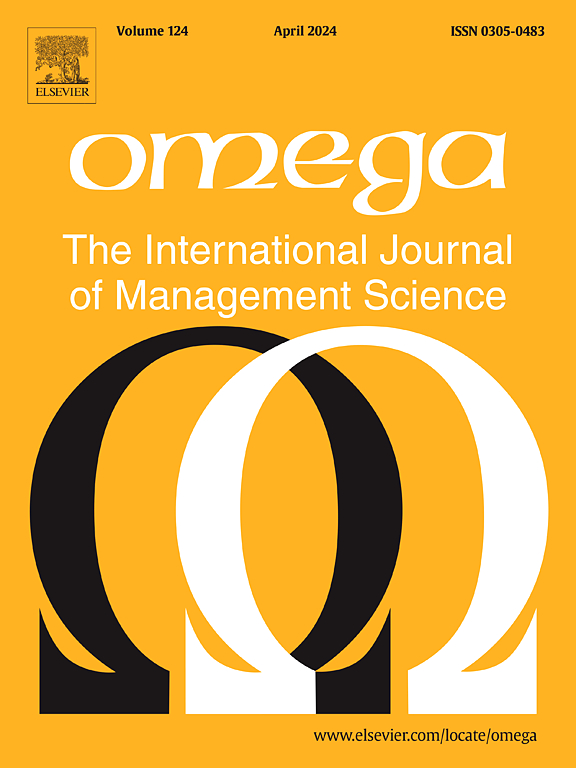具有弹性需求的利润导向枢纽线定位问题的柱生成与局部搜索
IF 7.2
2区 管理学
Q1 MANAGEMENT
Omega-international Journal of Management Science
Pub Date : 2025-09-02
DOI:10.1016/j.omega.2025.103419
引用次数: 0
摘要
人口增长和城市扩张导致全球多个主要城市的交通拥堵日益严重。在这种情况下,发展高效的公共交通网络对于确保足够的机动性至关重要。枢纽网络定位模型解决了公共交通网络的设计问题,以模拟和优化乘客的流动性。更具体地说,枢纽线定位问题(HLLP)在快速交通走廊和地铁线路的设计中起着至关重要的作用。在这项工作中,我们解决了以利润为导向的枢纽线定位问题(ED-HLLP),我们引入了一种列生成方法来解决混合整数模型的线性松弛问题,以及将列生成和局部搜索相结合的数学方法。所提出的方法导致计算原界和对偶界。我们评估了所提出的方法在HLLP文献中的一些经典数据集上的性能。此外,我们还进行了一项基于代表加拿大蒙特利尔大都市区的真实数据的研究。最后,我们进行敏感性分析,以评估驱动我们结果的主要属性,无论是从算法的角度还是从规划的角度。数值结果表明,所提出的方法产生了高质量的解决方案,减少了计算时间,并且比商业现成的求解器更有效地解决了模型的组合复杂性,从而允许解决较大的问题,否则后者无法处理。本文章由计算机程序翻译,如有差异,请以英文原文为准。
Column generation and local search for the profit-oriented hub-line location problem with elastic demands
Population growth and city sprawl have been driving increasing amounts of traffic congestion in multiple major cities worldwide. In this scenario, developing efficient public transportation networks becomes critical to ensure adequate mobility. Hub network location models address the problems of designing public transit networks to model — and to optimize — passenger mobility. More specifically, hub-line location problems (HLLP) play an essential role in the design of rapid transit corridors and subway lines. In this work we address the profit-oriented hub-line location problem (ED-HLLP) for which we introduce a column generation method to solve the linear relaxation of a mixed-integer model and matheuristic that combines column generation and local search. The proposed methodologies lead to the calculation of primal and dual bounds. We assess the performance of the proposed methods on some classic datasets from the HLLP literature. Furthermore, we conduct a study based on real-world data representing the metropolitan area of Montreal, Canada. Finally, we conduct a sensitivity analysis to assess the major attributes driving our results, both from an algorithmic point of view as well as from a planning perspective. The numerical results show that the proposed methods produce high-quality solutions, reduce computational times, and address the model’s combinatorial complexity more effectively than a commercial off-the-shelf solver, allowing for the solution of larger problems otherwise untractable for the latter.
求助全文
通过发布文献求助,成功后即可免费获取论文全文。
去求助
来源期刊

Omega-international Journal of Management Science
管理科学-运筹学与管理科学
CiteScore
13.80
自引率
11.60%
发文量
130
审稿时长
56 days
期刊介绍:
Omega reports on developments in management, including the latest research results and applications. Original contributions and review articles describe the state of the art in specific fields or functions of management, while there are shorter critical assessments of particular management techniques. Other features of the journal are the "Memoranda" section for short communications and "Feedback", a correspondence column. Omega is both stimulating reading and an important source for practising managers, specialists in management services, operational research workers and management scientists, management consultants, academics, students and research personnel throughout the world. The material published is of high quality and relevance, written in a manner which makes it accessible to all of this wide-ranging readership. Preference will be given to papers with implications to the practice of management. Submissions of purely theoretical papers are discouraged. The review of material for publication in the journal reflects this aim.
 求助内容:
求助内容: 应助结果提醒方式:
应助结果提醒方式:


